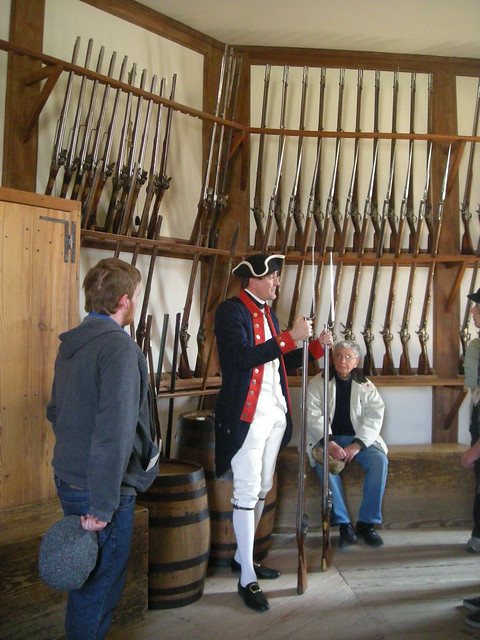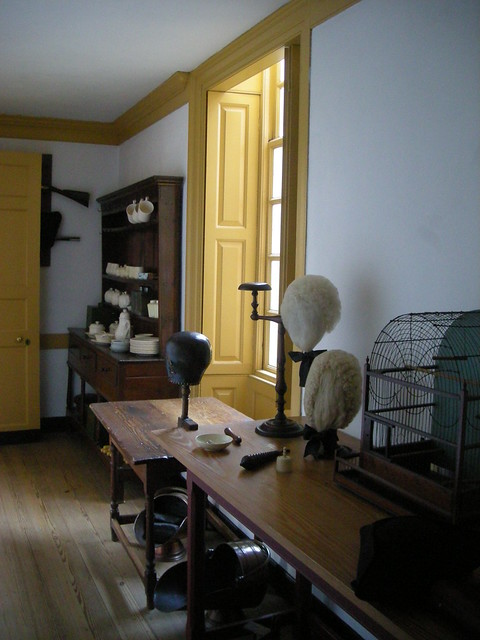Brenda Rosseau (manager of the Colonial Williamsburg Costume Design Center) and James Horn (vice president, Colonial Williamsburg Research and Historical Interpretation and Director of the John D. Rockefeller Jr. Library) welcomed the group to the conference and opened by giving a brief description of the use of costumes at CW. With over 800 employees to dress, the Costume Design Center currently has approximately 55,000 pieces in circulation, with an average of 50-60 items issued per employee. The staff at the CDC is responsible for the research, construction, and care of all costumes and accessories used by interpreters throughout the historic area, as well as those worn by the actors in the Emmy-winning Electronic Field Trips series. In addition, costuming comes to life in the historic area itself, where the mantua makers, milliners, and tailors of the Margaret Hunter shop practice and portray 18th century sewing techniques on a daily basis, producing entirely accurate pieces that are both worn and put on display in the shop.
Colonial Williamsburg interpreters, costumed by the CW
Costume Design Center.
The first formal presentation was given by Dr. Pravina Shukla (Indiana University) who discussed "Costume and Sites of Heritage." Dr. Shukla began by categorizing different types of heritage sites, such as those sites with educational goals, sites where history and culture are interpreted by professionals, or heritage sites that are only significant to the people, where no tourist or official interpreters are found. For this last type, she gave an example of some traditional costume in Sweden which is only worn for ceremonies as part of their own heritage preservation. Just like historical interpreters or reenactors, they strive to keep their costumes as accurate as possible. One of my favorite anecdotes from her presentation was a discussion with a Civil War reenactor who used his own independent research and the resources available to him in order to assemble his costume and persona to be meticulously correct. He felt that unless he was doing his best to portray his interpretation as accurately as possible, he would be doing the public a great injustice. And while he knows that he can never fully become the character he interprets, he would not want to wear something or do something in public that would embarrass the historical person he has taken the responsibilty to preserve and portray.
Next on the program was Dr. Jane Malcolm-Davies (director JMD and Company, The Tudor Tailor, Godalming, England) discussing "A World in a Wardrobe: Costume as Communication in Historic Sites." This fascinating study compiled data from sites currently utilizing costumed interpreters and discussed the use of costumes from the perspective of the costuming staff, the interpretive staff, and vistors themselves. She explored how much of sites’ budgets on average are allocated to costumes and why these sites decided to start using costumes in the first place. Information was also gathered concerning any procedures in place for training costumed staff (were they taught how to wear their costumes?), for the maintenance of the costumes (are interpretive staff in charge of cleaning their clothing?), and evaluation processes (do supervisors evaluate the staff's appearance?). Finally, she shared how the costumed interpreters felt about their costumes, including their attitudes about wearing them and how they felt it influenced the way they perform their jobs.
A costumed interpreter at the CW Magazine engages visitors in military discussions.
The final presenter in the first session was Heather M. Meiklejohn (costume curator, Parks Canada) who gave us an overview of her specific job challenges. As the sole costume curator for an extensive region, she does not even have the opportunity to visit all of the sites she manages in person. One of the neat ideas she shared with us is something Parks Canada has developed called “History Online.” This online resource for staff begins with a page listing all of the sites. From there, staff can explore each site and find anything they might need to know, like details about the educational offerings of the sites and even a section called “How to wear your costume.” This online “manual” is also available in hard copy or on a DVD for all staff. One of the biggest challenges, she explained, is getting the staff to actually read this and to refer to it when they have a question. In addition, they are beginning to explore additional interactive opportunities (such as facebook, flickr, Wikimedia, etc.) to reach out to staff and to encourage questions and conversation among staff and between sites.
After a quick coffee break, Session II: Case Studies began with “'The Devil’s Brood': Interpreting Henry II, His Family and Court at Dover Castle." Mark Wallis (managing and artistic director) and Stephanie Selmayr (director and head of costume, Past Pleasures Ltd., Godalming, England) shared with us some beautiful slides of the costumes and new interpretations at Dover Castle. They addressed the challenges posed when one is required to costume a period in which little to no extant examples remain, and images are inconclusive and often difficult to decipher.
Christopher Daley (historical clothing services supervisor, Jamestown-Yorktown Foundation) followed with his presentation titled, “Counterfeited According to Truth”: The Challenges of Accurately Clothing Powhatan Indians at Jamestown Settlement." I really enjoyed Mr. Daley’s presentation, in which he clearly discussed where their costuming inspirations came from, what their specific challenges are, and how they overcome those challenges. Because Jamestown is a state-owned site, he explained, certain concessions need to be made, which often conflict with the historical accuracy of their interpretation (for example, wearing latex gloves when slaughtering animals or safetly glasses when working with hot metals). Another very interesting topic which he brought up was public perception; when visitors come to a site, they bring certain preconceptions and expectations. In some cases, those preconceptions are wrong, and visitors consequently have trouble accepting the truth, which in other cases, they struggle with putting their preconceptions aside to focus on the interpretation. For instance, some of the interpreters who portray the Powhatans are not Native Americans, so the public sometimes has trouble seeing beyond this necessary inaccuracy of portrayal to learn from the interpretative actions, settings, and lessons being offered by the interpreters.
Wigs on display at the Governor's Palace, CW.
The final presentation prior to lunch was Denise Lebica (manager, historical clothing and textiles, Plimoth Plantation, Plymouth, Massachusetts) with “Dressed to Till: Clothing as an Interpretive Tool.” She described how Plimoth teaches their interpretive staff how to wear their costumes and to be aware of what they are doing and how their clothes should change to fit the task at hand. For example, when staff are preparing to do some sort of dirty work, they make sure that visitors see them put on their aprons; this conveys through the physical use of clothing the fact that since clothing was valuable, Plimoth's settlers would have done their best to protect it while they worked. One neat tool they sometimes use in interpreter training is bringing the people of a painting to life. After looking closely at the painting, a staff member appears wearing the same clothes, which gives the trainees a sort of 3D view of how the clothes are actually worn in the past.
I was told from the café staff at the DeWitt Wallace that Brunswick stew would be on the menu for Thursday, and I was so looking forward to it! Alas, when I arrived at the café on Thursday, I was greeted with the sad news that the stew never made it, but was promised that it would be there the next day. So we ran over to the Cheese Shop once again and spent the remainder of our lunch time shopping in the historic area.
Stay tuned for more!
Stay tuned for more!




3 comments:
That's interesting to hear museum costumers from around the world share their stories. I think the defining trait of an interpreter is the level of research they put in to their persona to carry the manner, dress, knowledge, etc to portray the past. Some will read all the museum documentation pamphlets, etc and some sadly won't. Perhaps conferences like this will help to inspire the ones who don't study up as much! If they knew people like us care, they might be encouraged to do more. =)
Laurie
Laurie,
One of the issues we touched on briefly at the conference was first person interpretation versus third person. (Unfortunately, most of the presentations/research did not differentiate the use of costumes between the two.) I think that most first person interpreters are already dedicated enough to the practice that they usually do take more care in their costumes, etc. Whereas third person interpreters (or staff who are situated just to greet visitors) perhaps don't feel as "involved" in the history, and therefore probably don't care to research as much. An interesting discussion for another time I guess!
-Ashley
Hmmm, interesting. Actually I think I have heard a few interpreters express costuming in those distinctions.
Laurie
Post a Comment